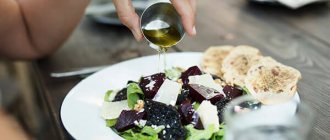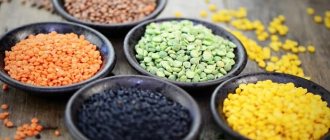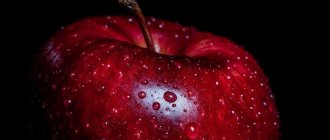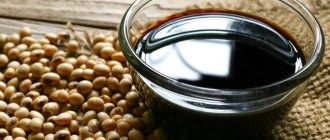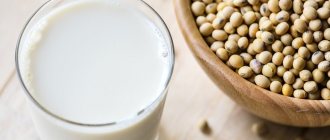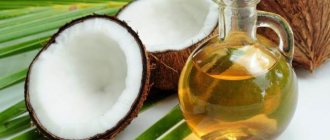Use in cooking
Herring acquires its taste after processing.
The most popular method is weak salting, during which the fish matures. As a result, the meat softens and a so-called “herring bouquet” is formed. Fatty, lightly salted, smoked and marinated fish is widely used as a good snack product. At the same time, frozen herring is available for sale, intended for preparing home canned food or frying. In different countries, mincemeat is prepared from it, put into salads (“Shuba”), pies, stuffed into eggs and served as a side dish for beans, potatoes, and vegetable stews.
https://www.youtube.com/watch?v=ytadvertise
To enrich the taste, herring is seasoned with vegetable oil, apple cider vinegar, lemon juice, and onions (leek, green, onion) are added.
After catch, fish quickly deteriorates, so it requires immediate processing: freezing, salting, pickling or frying.
Interestingly, if a person craves herring, his body experiences a lack of “right fats.” To compensate for the deficiency of polyunsaturated fatty acids, enrich your diet with foods containing omega-3,6,9: vegetable oils, avocados, nuts, duck, salmon, mackerel.
Chemical composition
Herring is considered a common type of fish on the globe, so even people with a modest income can afford it. Its dimensions vary from 25 to 45 centimeters, and its weight reaches 400 grams. Astrakhan salted herring “zalom” is especially valued for its meatiness and spicy taste.
All representatives of the herring genus are used in the food industry for the production of fishmeal.
Table No. 1 “Nutritional value of herring”
| Name | Nutritional value of fish per 100 grams of product |
| Calorie content of fried herring | 265 calories |
| Calorie content of salted herring | 240 calories |
| Calorie content of smoked herring | 218 calories |
| Calorie content of pickled herring | 155 calories |
| Fats | 18.5 grams |
| Squirrels | 17.5 grams |
| Water | 60.3 grams |
| Saturated fatty acids | 4.0 grams |
Table No. 2 “Chemical composition of herring”
| Nutrients | Content of nutrients per 100 grams of product, milligrams |
| Vitamins | |
| Choline (B4) | 65 |
| Niacin (RR) | 3,217 |
| Tocopherol (E) | 1,07 |
| Ascorbic acid (C) | 0,7 |
| Pantothenic acid (B5) | 0,645 |
| Pyridoxine (B6) | 0,302 |
| Riboflavin (B2) | 0,233 |
| Thiamine (B1) | 0,092 |
| Retinol (A) | 0,028 |
| Cyanocobalamin (B12) | 0,01367 |
| Folic acid | 0,01 |
| Calciferol (D) | 0,0042 |
| Phylloquinone (K) | 0,0001 |
| Macronutrients | |
| Potassium | 327 |
| Phosphorus | 236 |
| Sodium | 90 |
| Calcium | 57 |
| Magnesium | 32 |
| Microelements | |
| Iron | 1,1 |
| Zinc | 0,99 |
| Copper | 0,092 |
| Selenium | 0,0365 |
| Manganese | 0,032 |
Composition and calorie content of turnips
Turnips contain almost all existing acids, most macro- and microelements and vitamins.
The calorie content of turnips per 100 is 22 kcal, of which:
- Proteins - 3.17 g;
- Fats - 0.49 g;
- Carbohydrates - 2.85 g;
- Dietary fiber - 2.7 g;
- Water - 92.55 g;
- Ash - 0.93 g.
Vitamins per 100 g:
- A, RE - 131 mcg;
- Beta-carotene - 1.573 mg;
- Lutein + Zeaxanthin - 1121 mcg;
- B1, thiamine - 0.162 mg;
- B2, riboflavin - 0.129 mg;
- B4, choline - 18.3 mg;
- B5, pantothenic acid - 0.322 mg;
- B6, pyridoxine - 0.171 mg;
- B9, folic acid - 83 mcg;
- C, ascorbic acid - 20.2 mg;
- E, alpha tocopherol, TE - 1.62 mg;
- K, phylloquinone - 224 mcg;
- RR, NE - 1.221 mg;
- Betaine - 0.3 mg.
Macroelements per 100 g:
- Potassium, K - 196 mg;
- Calcium, Ca - 108 mg;
- Magnesium, Mg - 22 mg;
- Sodium, Na - 33 mg;
- Phosphorus, Ph - 73 mg.
Microelements per 100 g:
- Iron, Fe - 2.14 mg;
- Manganese, Mn - 0.395 mg;
- Copper, Cu - 42 μg;
- Selenium, Se - 1 μg;
- Zinc, Zn - 0.77 mg.
Digestible carbohydrates per 100 g:
- Mono- and disaccharides (sugars) - 0.38 g;
- Glucose (dextrose) - 0.1 g;
- Sucrose - 0.11 g;
- Fructose - 0.17 g.
Essential amino acids per 100 g:
- Arginine - 0.172 g;
- Valine - 0.153 g;
- Histidine - 0.066 g;
- Isoleucine - 0.104 g;
- Leucine - 0.17 g;
- Lysine - 0.198 g;
- Methionine - 0.048 g;
- Threonine - 0.106 g;
- Tryptophan - 0.043 g;
- Phenylalanine - 0.128 g.
Essential amino acids per 100 g:
- Alanine - 0.124 g;
- Aspartic acid - 0.36 g;
- Glycine - 0.123 g;
- Glutamic - 0.549 g;
- Proline - 0.131 g;
- Serine - 0.099 g;
- Tyrosine - 0.075 g;
- Cysteine - 0.039 g.
Fatty acids per 100 g:
- Palmitic – 0.043 g;
- Stearic – 0.006 g;
- Heptadecene - 0.017 g;
- Oleic – 0.009 g;
- Linoleic acid - 0.017 g;
- Linolenic – 0.113 g;
- Omega-3 - 0.113 g;
- Omega-6 - 0.017 g.
Product calculator
Enter the quantity of the product “Salted Herring” to calculate its nutritional value
| Property | Meaning | % of normal | |
| Calorie content, kcal | 88 | 4.4 | 4.4% |
| Proteins, g | 17,5 | 11.33 | 11.33% |
| Fats, gr | 2 | 4.55 | 4.55% |
Enter the quantity of the Herring product to calculate its nutritional value
| Property | Meaning | % of normal | |
| Calorie content, kcal | 217 | 10.85 | 10.85% |
| Proteins, g | 24,58 | 16 | 16% |
| Fats, gr | 12,37 | 27.27 | 27.27% |
Herring roe
Often when purchasing fish, we find milt or caviar in the carcass, which are no less healthy than the fillet part. However, not all housewives know what the value of the product is and what to do with it.
The Japanese know firsthand about the beneficial properties of herring caviar. True seafood connoisseurs are willing to pay a lot of money for it, while European housewives put it in the trash, underestimating the uniqueness of this product.
Herring caviar is a mass of eggs of female fish; it is a storehouse of nutrients. It contains: phosphorus, iron, potassium, magnesium, selenium, zinc, vitamins A, B, E, D, lecithin, “good” cholesterol, omega-3 acids.
Effect on the human body:
- increases hemoglobin in the blood due to the production of new red blood cells;
- participates in the formation of new skin cells;
- regulates blood pressure;
- restores damaged skin areas, prevents aging;
- tones and refreshes the dermis, removes age spots, smoothes wrinkles;
- nourishes the thyroid gland;
- strengthens the immune system;
- improves brain function.
Herring caviar can be consumed as an independent product, or with potato and vegetable side dishes, as a basis for making sandwiches. Due to its healing effect on the skin, it is used in cosmetology as part of masks to improve the condition of fading, problematic teenage dermis.
Contraindications for use: disorders of the liver, kidneys, gastritis with high acidity, stomach ulcers, hypertension. In these cases, taking a lightly salted product can aggravate the course of the disease.
Content of vitamins and microelements
Unlike other root vegetables (cabbage, carrots, beets, radishes), turnips are not as rich in vitamins and minerals. However, it is characterized by a fairly high content of vitamin C (22% of the daily value), silicon (303%), boron (70%), calcium (10%), potassium (10%). Turnips also contain vitamins B1, B2, B3, B6, B9, PP, minerals magnesium, manganese, iron, copper, selenium, zinc and various amino acids. Turnip leaves contain 2-3 times more vitamins and microelements than root vegetables.
Micro- and macroelements in salted herring
Herring contains the following elements: SFA - Saturated fatty acids, MUFA - Monounsaturated fatty acids, PUFA - Polyunsaturated fatty acids, Cholesterol, Sodium, Potassium.
| Micro and macro element | Meaning |
| SFA - Saturated fatty acids, g. | 2,791 |
| MUFA - Monounsaturated fatty acids, g. | 5,112 |
| PUFA - Polyunsaturated fatty acids, g. | 2,919 |
| Cholesterol, mg | 82 |
| Sodium, mg | 918 |
| Potassium, mg | 447 |
| Product | Kcal | Proteins, g | Fats, g | Angle, g |
| Pickled Herring | 262 | 14,19 | 18 | 9,64 |
| Herring | 217 | 24,58 | 12,37 | 0 |
| Salted herring | 88 | 17,5 | 2 | 0 |
| Canned herring | 88 | 17,5 | 2 | 0 |
| Herring fish | 88 | 17,5 | 2 | 0 |
| Smoked herring | 217 | 24,58 | 12,37 | 0 |
| Atlantic herring, smoked | 217 | 24,58 | 12,37 | |
| Atlantic herring, pickled | 262 | 14,19 | 18 | 9,64 |
| Atlantic herring, cooked in the heat | 203 | 23,03 | 11,59 | |
| Atlantic herring, raw | 158 | 17,96 | 9,04 | |
| Pacific herring, cooked in the heat | 250 | 21,01 | 17,79 | |
| Pacific herring, raw | 195 | 16,39 | 13,88 | |
| Atlantic herring | 246,3 | 17,7 | 19,5 | |
| Atlantic fatty herring | 248 | 17,7 | 19,5 | |
| Atlantic herring low-fat | 135 | 19,1 | 6,5 | |
| Iwasi herring | 182,3 | 20,5 | 11,1 | |
| Iwasi herring, large | 182,3 | 20,5 | 11,1 | |
| Iwasi herring, small | 182,3 | 20,5 | 11,1 | |
| Pacific herring | 191 | 14 | 15 | |
| Fatty Pacific herring | 191 | 14 | 15 | |
| Pacific herring low-fat | 135 | 18 | 7 | |
| Atlantic herring, medium salted | 145 | 17 | 8,5 | |
| Pacific herring, medium salted | 224 | 17,4 | 17,1 | |
| Herring, Azov-Black Sea | 88 | 17,5 | 2 | |
| Herring, Caspian (Volga) | 88 | 17,5 | 2 | |
| Herring, Caspian (Volga), large | 88 | 17,5 | 2 | |
| Herring, Caspian (Volga), medium | 88 | 17,5 | 2 | |
| Herring, Caspian (Dolgan) | 88 | 17,5 | 2 | |
| Herring, Caspian (Dolgan), large | 88 | 17,5 | 2 | |
| Herring, Caspian (Dolgan), medium | 88 | 17,5 | 2 | |
| Herring, Pacific, lightly salted | 88 | 17,5 | 2 | |
| Pacific fatty herring, cold smoked | 225 | 20,3 | 16 |
Salted herring contains the following elements: Water, Chromium, Fluorine, Molybdenum, Nickel, Zinc, Chlorine.
| Micro and macro element | Meaning |
| Water, city | 70 |
| Chromium, µg | 55 |
| Fluorine, mcg | 430 |
| Molybdenum, mcg | 4 |
| Nickel, µg | 6 |
| Zinc, mg | 0,7 |
| Chlorine, mg | 165 |
Herring milk
Milk is the seminal fluid of male fish, the main value of which lies in the presence of easily digestible animal protein in its composition. When ripe, they have a milky white tint and are most beneficial for humans: they contain essential fatty acids (omega-3), amino acids (glycine), magnesium, sodium, iron, vitamins A, E, C, PP, B1, B2, B12 .
In addition to replenishing the deficiency of nutrients in the body, they prolong the period of absorption of medications into the blood, have an anti-inflammatory effect, stimulate protective functions to combat pathogens, and improve wound healing.
The calorie content of herring milk is 100 calories per 100 grams of product. Due to their easy digestibility and high nutritional value, they are indicated for people to restore strength after illness and for athletes. Children under 5 years of age should limit use of the product.
The nutritional value
Almost half of the periodic table is represented in turnips. This unique vegetable crop contains the antioxidant glucoraphanin, which increases the body's protective functions, regulates blood sugar levels, and also prevents the growth of cancer cells. Organic acids - linoleic, linolenic, oleic, palmitic are responsible for the cellular structure of tissues, ensuring their production and regeneration. Plant fiber has a beneficial effect on the gastrointestinal tract, helps reduce the level of “bad” cholesterol, and removes toxins and waste.
Proteins fats carbohydrates
100 g of Brassica rapa root vegetable contains:
- 1.48 g protein;
- 0.1 g fat;
- 6.18 g carbohydrates;
- 0.26 g starch;
- 1.8 g fiber;
- 0.68 g organic acids;
- 89.5 g water.
Macro- and microelements
Macro- and microelements are necessary to ensure the normal functioning of all body systems: they stimulate hematopoiesis, improve the supply of oxygen to tissues, regulate water balance, help strengthen bones, take part in the metabolism of fats and carbohydrates, protein synthesis, and enzymatic reactions. A person's need for macroelements is measured in grams or milligrams; our body needs much less microelements.
Brassica rapa vegetable contains:
| Macronutrients | mg/100 g | Microelements | mg/100 g |
| Potassium | 238 | Iron | 0,9 |
| Calcium | 50 | Copper | 42 |
| Sodium | 18 | Manganese | 0,4 |
| Magnesium | 17 | Selenium | 55 |
| Sulfur | 32 | Zinc | 0,78 |
| Phosphorus | 34 |
Vitamins
Low molecular weight organic substances, combined into the group of vitamins, are absolutely necessary for the normal functioning of the human body. Most of them are not synthesized in the body, but come from food.
The complex of vitamins in Brassica rapa root vegetables is represented by the following types:
| Name | mg/100 g | Role in the body |
| A (retinol) | 16,9 | Participates in redox processes, normalizes the functioning of the immune system. |
| B1 (thiamine) | 0,05 | Helps strengthen the nervous system. |
| B2 (riboflavin) | 0,04 | Takes part in metabolic processes. |
| E (tocopherol) | 0,09 | A powerful antioxidant that slows down the natural aging process. |
| C (ascorbic acid) | 19,9 | Increases resistance to infectious diseases, participates in cellular regeneration processes. |
| PP (niacin, nicotinic acid) | 0,77 | Participates in protein and carbohydrate metabolism, regulates the amount of cholesterol in the blood. |
| Beta carotene | 0,09 | Provitamin A. |
Due to such a unique composition, turnips can easily be called one of the most useful foods. After Peter I forcibly introduced potatoes into the Russian diet, this vegetable began to be undeservedly forgotten. However, recently, interest in the early-ripening and productive representative of the cabbage species has been revived, which is also facilitated by the widespread passion of people for a healthy lifestyle. Eating such a high-quality dietary product helps strengthen the body and maintain a slim figure without resorting to exhausting diets.
The benefits of herring
It is difficult to find a fish that can surpass herring in its beneficial properties. This is a real gift from the sea! In Sweden there is a common saying: “the herring is on the table, the doctor is on the sidelines.” And for good reason: fish contains 20% easily digestible protein and omega-3 fatty acids, which are beneficial for the heart and blood vessels. In addition, herring increases the amount of high-density lipoproteins (“good cholesterol” in the blood), which reduce the risk of atherosclerosis and the development of dangerous cardiovascular pathologies.
Herring fat is rich in antioxidants and helps reduce adipocytes that cause type 2 diabetes. Fish contains a record amount of vitamin D (three daily norms of the compound are concentrated in 100 grams of fillet), so it is especially useful for people in winter, when the human body lacks direct sunlight.
The effect of herring on the body:
- normalizes vision;
- improves bone growth, brain and kidney function, blood flow in capillaries;
- regulates blood pressure;
- reduces the symptoms of psoriasis;
- increases hemoglobin levels;
- accelerates skin cell regeneration;
- cleanses the human body of oxidation products.
Useful properties of turnips
It is best to consume it raw, as it retains all the substances the body needs.
This root vegetable is especially recommended to be included in the diet menu during weight loss and diabetes. Its positive effect on the heart, blood vessels, kidneys, teeth, joints, vision, and organs of the respiratory system has been noted. This vegetable is very useful for children and the elderly with weak immunity. Considering the effects of consuming turnips, the following should be noted:
- Relieves toothache
. This is relevant only if it is caused not by a destructive process in dentin, but by simple nervous overstrain, poor quality oral care, or increased sensitivity of the enamel. - Improves the condition of ENT diseases
. These include tonsillitis, laryngitis, pharyngitis, ARVI, sinusitis, etc. As a result, the temperature passes faster, strength appears, and immunity increases. - Eliminates chronic constipation
. We can talk about this when they are the result of a sedentary lifestyle, poor nutrition and constant stress. If the cause is colitis or gastritis, turnip will not help, rather the opposite. - Lowers blood sugar levels
. This effect is possible only if you follow a low-carbohydrate diet that excludes flour and sweets. We are talking about both type 1 and type 2 diseases. - Restores joints
. Turnip cleanses of toxins, salts and waste, improving mobility and blood circulation in them. - Normalizes metabolism
. This is achieved by stimulating the production of gastric juice, reducing cholesterol levels in the blood, and cleansing the intestines. - Brings order to the kidneys
. This is especially useful for pyelonephritis, microliths and stones, when you need to reduce the consumption of vegetables with “aggressive” juice. - Helps you lose weight
. This is not surprising, because the product is low-calorie, contains a lot of water and normalizes metabolism.
Turnip has parasitic, diuretic, expectorant, analgesic, sedative and anti-inflammatory effects.
It is enough to consume only 100-200 g 2-3 times a week to see an improvement in your well-being. Note! Both the pulp and the juice of the vegetable are very useful, which is recommended to drink for arthritis, rheumatism, and cardiovascular diseases. It improves immunity, gives strength, and makes muscles more elastic.
Potential Harm
Considering that most people prefer to eat herring lightly salted, it is important not to overdo it with portions. Remember, 1 gram of table salt binds up to 100 milliliters of water, causing dehydration. This is especially fraught in the summer, when due to the heat a person intensively loses moisture through sweat.
100 grams of Pacific salted herring contains 14.8 grams of salt, and lightly salted herring contains 6.3 grams. To restore the water-salt balance in the body after consuming the product, you need to drink at least 1 liter of water. Oversaturation of the body with salt increases the load on the heart and causes fluid retention.
In addition, the harm of fish is associated with its ability to secrete the amino acid tyramine, which is formed during the process of tissue decay of protein-containing products. The substance reduces serotonin levels, increasing blood pressure and causing migraines. Therefore, doctors recommend that people with impaired kidney function, suffering from edema of various etiologies and hypertensive patients not get carried away with this product.
For ulcers, enterocolitis, gastritis with high acidity, fish is allowed to eat no more than 100 grams per day, boiled or soaked in milk, strong tea (to reduce the salt content in it and, as a result, reduce the irritant effect on the mucous membrane of the stomach and intestines) .
The beneficial and harmful properties of herring directly depend on the ecology of the world: all seafood accumulates toxic compounds from the environment during its life cycle. Biphenyls and dioxins destroy the endocrine system, reduce libido, cause endometriosis in women, suppress the immune system, and cause infertility.
Doctors do not strictly prohibit the consumption of fish for these categories of people. However, during breastfeeding, carefully monitor the baby's reaction to milk after taking herring. Remember, any fish is a strong allergen, so it should be consumed in reasonable quantities in the absence of contraindications.
Pickling recipes
Herring is an integral product of the holiday table. Most often, housewives use salted fish in the process of preparing dishes. It is used to make herring under a fur coat, salad rolls, vinaigrette, tartar, mincemeat, appetizers, zrazy, and casseroles. In addition, the fish is served simply cut into pieces under aromatic sunflower oil, with onions, often with boiled jacket potatoes.
To avoid these incidents, salt the herring yourself, choosing an acceptable set of spices to suit your own taste.
First of all, you need to buy or catch fresh fish. The tenderness and taste of the finished dish depend on the quality of the herring chosen for pickling. Due to the deteriorating environment, it is recommended to give preference to the Pacific or Atlantic type instead of sea fish, which may contain toxins and heavy metals.
Selection criteria:
- The herring carcass should not be heavily crushed or compressed, and the surface of the skin should be intact, smooth, and without spots.
- The color of good quality fish is silver. The yellowish tint of the scales indicates a violation of storage conditions and “old age” of the herring. This product should not be eaten.
- The fins and gill covers of fresh fish are tightly pressed to the body, the eyes are convex, clear.
Do not buy headless herring, as often unscrupulous sellers thus try to hide low-quality goods, depriving the buyer of the opportunity to determine its freshness. Good fish have gills that are characteristically dark red, without a single light color.
The appearance of blood when pressing on the gills indicates a violation of the salting technology.
- A thick belly indicates that the herring contains caviar or milt.
- Fish should not emit foreign odors other than their own.
To pickle fresh-frozen herring, it must first be thawed. This must be done without loss of beneficial qualities, structure and taste. Don’t rush and speed up the thawing of the fish (put it in hot water, microwave), otherwise you will ruin it. It is correct to defrost herring in the refrigerator at a temperature of 5 degrees during the day.
Before you start preparing the brine, carefully remove the gills from the fish using scissors or a knife. Then rinse the carcass under running cold water. This will remove the bitter taste from the finished product. Fish can be salted whole or pre-gutted. In the first case, it will evenly absorb the required amount of salt and spices over the entire surface and the taste will be correct; in the second, it will cook faster. If caviar or milt is found, they are salted along with the carcass.
The duration of the salting process depends on the size of the fish, individual preferences, and the desire to obtain highly or lightly salted herring. A whole carcass can be kept in a spicy solution in a cold place for up to 7 days.
For quick express salting, in addition to removing the gills, cut off the head, remove the films (internal, external) from the carcass, remove the entrails and intestines, wash under cold water, cut into pieces or profile the meat, and place in the solution. In this version, the herring will be ready in 3 to 5 hours, but the original taste can be modified.
Ingredients:
- water – 1 liter;
- whole herring – 2 pieces;
- sugar – 7.5 grams (1.5 teaspoons);
- salt – 50 grams (4 dessert spoons);
- dried carnation flowers – 5 pieces;
- bay leaf – 4 pieces;
- allspice – 10 peas.
Cooking method
- Boil water in a saucepan, add spices, salt, sugar.
- Cool the brine, pour it over the fish, leave at room temperature for an hour, then put it in the refrigerator for 2 to 7 days.
- Before serving, cut into pieces, garnish with pickled onions and herbs.
Ingredients:
- water – 900 milliliters;
- whole herring – 2 pieces;
- mustard – 30 grams (2 tablespoons);
- sugar – 45 grams (3 tablespoons);
- salt – 75 grams (5 tablespoons);
- chopped herbs (dill or parsley) – 15 grams (1 tablespoon);
- coriander seeds – 15 grams (1 tablespoon);
- bay leaf – 10 pieces;
- black pepper – 15 peas.
Cooking sequence:
- brush the fish with mustard and place in a glass container (enamel or plastic dishes will give the fish a metallic taste);
- boil water in a saucepan, add salt, sugar, spices;
- cool the brine, pour over the carcasses, leave the herring to marinate for 2 hours;
- put in a cool place for three days.
Method for preparing brine:
- Boil a liter of water, slowly add salt to the liquid until it stops dissolving. Visually, you will see that the crystals simply begin to settle to the bottom.
You can check the readiness of the brine using a raw egg: lower it into the water; if it starts to sink, this indicates an insufficient amount of salt in the water, and if it floats on the surface, the brine is ready.
- To improve the taste, add spices to the liquid, based on your own preferences. These can be: black, white, red ground or allspice, clove buds, bay leaves and juniper berries. Cardamom grains, coriander seeds, mustard seeds, vinegar, onions, horseradish, green sour apple, lemon juice, vodka, and soy sauce will not spoil the taste. However, it is not recommended to use iodized salt to prepare brine.
- Place two herring carcasses in a bowl, pour cooled brine over the fish so that it “swims” in the brine. Let it sit for an hour, then put it in the refrigerator for 1 – 2 days.
Dry pickling
Ingredients:
- large whole herring – 1 carcass;
- ground black pepper – 7.5 grams (1.5 teaspoons);
- sugar – 5 grams (1 teaspoon);
- salt – 7.5 grams (1.5 teaspoons).
Recipe:
- Wipe the fish dry with a paper towel or napkins;
- mix black pepper, salt, sugar in a glass container;
- thoroughly rub the fish carcass with the mixture on all sides, including the empty cavity under the gill covers;
- Wrap the herring tightly in three layers of cling film and place in the refrigerator for 2 days.
Cooking method:
- Peel the herring, gut it, cut into pieces;
- provide the fish with salt and spices, leave for half an hour;
- beat the egg, add flour;
- put the frying pan on the fire, add vegetable oil;
- Bread each piece of herring in egg and flour, fry until cooked on both sides;
- Place on a napkin to drain excess fat.
Fried fish is recommended to be served with fresh vegetables.
Remember, when exposed to air, herring fat oxidizes under the influence of oxygen, which leads to the appearance of a rancid taste, unpleasant odor and “rusty” color. Cut fish is stored exclusively in vegetable oil, and whole fish is stored in brine or marinade.
Application
Herring can be served as a cold appetizer with vegetables, used in various kinds of salads, or eaten simply chopped with onions and vegetable oil.
Market Analytics
- Black Lives Matter movement: reaction and consequences for the beauty industry
- COVID-19 is changing the rules of the game in the cosmetics market
- Beauty of the future: cosmetic innovations 2020
Convenient search for beauty salons on our website
Beauty salons in Moscow Beauty salons in St. Petersburg Beauty salons in Ekaterinburg Beauty salons in Novosibirsk
Latest blog posts on our website
- Naturecream / Apricot kernel oil for face
- Naturecream / MATRIXYL3000 - the best skin elasticity stimulator
- Naturecream / SPF in Natural Oils
- Naturecream / Geranium (Pelargonium) oil for skin health and beauty
- Prostye-sovety / Save on a beauty salon: procedures that can be done at home
- Naturecream / Growth Factor - brings back youth?
- Oksana-Lezina / 3 effective abdominal exercises from a fitness instructor for beginners
- Prostye-sovety / Making perfect curls at home
- Prostye-sovety / Which hair removal method to choose
- Naturecream / Wrinkles Puppets
Latest forum topics on our website
- Natalya / How to properly make a gelatin mask?
- Mrs._Smith / Badly sunburned! What to do?((
- Ice / Is it necessary to combine fitness classes with a diet?
- Antonova / What can be used for hair loss?
- Radio operatorKat / Who was on a protein diet?
Other articles in this section
| Hot smoked cod Cod belongs to the cod family and is usually found in the Atlantic Ocean. Moreover, there are several subspecies of this fish, determined by geographical location: Baltic, White Sea, Arctic Cod. The maximum length is 1.8 m, but smaller individuals are caught on an industrial scale. This fish is distinguished by its bright and attractive color with specks, its belly is white, and there is a small antennae on the chin. |
| Caspian carp The difference between the characteristics and properties of these two types of fish is so small that the carp can easily be called a sea carp. Unlike freshwater carp, whose population is widespread in the basins of many European rivers, carp is not a picky fish. Easily tolerates salty sea water. He quickly gains weight by eating various foods, including plant foods. The Caspian carp does not go to the floodplains to spawn, as other types of carp do. It is one of the valuable commercial fish species. |
| Fried sea cucumber Sea cucumbers are commercially edible invertebrate animals, a species of echinoderm, from the class of sea cucumbers. The body is elongated, almost trapezoidal, slightly flattened at the bottom. They reach a length of over 40cm. Body weight can be about 1.5 kg. Life cycle 9-11 years. The main habitat is the coasts of Asia, Australia, Africa, and Russia. |
| Boiled pike perch Pike perch can live only in those rivers where the water is sufficiently clean. If suddenly the river begins to become polluted with waste, the fish begins to get very sick and eventually die. There are many cases when, after accidents at factories, the water in nearby rivers became polluted and all the fish died. But at the same time, pike perch can extremely rarely become infected with any disease. |
| Poached catfish Being a freshwater fish, catfish lives in reservoirs with running water. It can often be found in rivers, especially in places where there are deep holes. The catfish reaches up to five meters in length. There are individuals that weigh up to half a ton. The permanent habitat of this fish is the central part of Europe. Catfish are also found in the central regions of America and the southern territories of Canada. This species belongs to the catfish family. It has no scales and is dark yellow or completely black. |
| Stuffed pike Pike is a freshwater fish. One of the most popular in cooking. Pike dishes are tasty, nutritious, healthy and dietary. A festive table setting is not complete without culinary masterpieces using this fish. |
| Poached pike perch Pike perch is a fish that lives exclusively in fresh water bodies. This type of fish leads a rather predatory lifestyle - its diet includes small fish and invertebrates. This diet forces pike perch to lead a fairly active lifestyle, so its meat is very dietary. It is used in various diets, as it can enrich the body with essential nutrients without harm to the figure and health. Also an important advantage over other fish, and not only freshwater ones, is the absence of bones. The most delicious and healthy dish is pike perch cooked using the poaching method. This method of cooking allows the meat to be very tender and not lose its beneficial properties. |
| Zuban Zuban is a marine fish whose habitat is preferably the Pacific, Atlantic and Indian oceans. However, this species is often found in the Black Sea (British Isles and Mauritania). This fish received its unusual name because of its interesting appearance, in particular because of its teeth in the form of huge fangs. |
| Fresh squid Squid is a very popular type of sea mollusk. Most often, squid individuals are found in small sizes. As a rule, they do not reach a length of 30 cm. But there are also known individuals that grow to gigantic parameters, for example, up to 20 meters long and weighing 300 kilograms. |
| Grilled salmon This is a valuable commercial fish with an unpretentious character. The habitat is not limited to any specific conditions. Salmon can change color as easily as their lifestyle. Mountain streams of North Africa and North America, rivers of Portugal and Spain, the Atlantic and the Arctic Ocean. |
